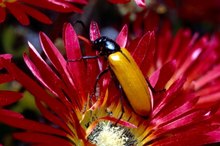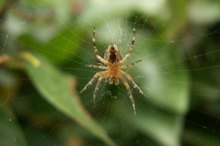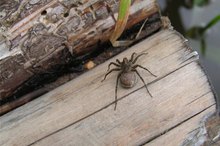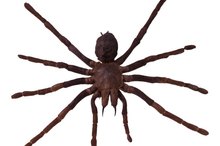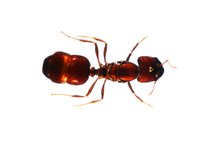Common Symptoms of a House Spider Bite
House spiders belong to a species in the Tegenaria group, according to GreenNature.com 1. This species group includes the hobo spider, domestic and common house spider and the giant house spider 3. The hobo spider is the most dangerous in this group, but is found mostly in the Pacific Northwest 3. Children, Youth and Women's Health Service of Australia points out that occasionally the house spider will bite and produce a few symptoms, especially at the site of the bite 2.
Pain
The house spider bite can cause pain in the small area surrounding the wound. Children, Youth and Women's Health Service of Australia suggests an ice pack to relieve the pain at the site of the bite 2. HoboSpider.org, a web reference created by Darwin K. Vest, a renowned spider expert, points out that the actual bite might not be painful.
Swelling
Symptoms of a Black House Spider Bite
Learn More
Some tissue swelling is possible, depending on the individual's response to the spider bite, as well as whether the spider injected venom. HoboSpider.org suggests the spider is not likely to inject a human with venom because it would be biting out of defense and not trying to feed on the human prey.
Tissue Hardening
Most house spider bites can cause a hardening of tissues that surround the bite 4. HoboSpider.org says the hardening resembles a classic mosquito bite.
Blistering
Poisonous Wood Spiders
Learn More
In more serious cases, the surrounding area may develop blisters 24 to 48 hours after the bite, according to HoboSpider.org. These blisters can rupture 24 hours after development, leaving an open wound.
Healing
The open lesions can begin to scab over and heal. A bull's-eye type rash can appear surrounding the open wound nearly three weeks after the original bite. HoboSpider.org points out that about 45 days after the bite, you will see a scar form in place of the scabbed-over ulcer.
Systemic Reactions
Systemic, or full body, reactions to a house spider bite can include:
- a severe headache that does not respond to pain relievers
- dry mouth
- nausea
- weakness
- lethargy
- hallucinations
- double vision
- blurred vision
- joint pain
- according to DermNetNZ.org
It is possible for the individual to notice these symptoms between one and three hours after the spider bite occurs. Other symptoms can include
- chest
- abdomen pins
- trouble breathing
- rapid heart rate
- sweating
- fever
- increased salivation or a reduction in blood pressure (which could result in dizziness or fainting)
Related Articles
References
- Green Nature: House Spiders
- Children, Youth and Women's Health Service: Spider Bites
- Hobo Spider: Poison
- Derm Net NZ: Spider Bites
- Illinois Department of Public Health. Brown Recluse and Black Widow Spiders.
- Cedars Sinai Medical Center. Brown Recluse and Black Widow Spider Bites in Children.
- Sotelo-cruz N, Gómez-rivera N. [Neurotoxic manifestations of black widow spider envenomation in paediatric patients]. Neurologia. 2016;31(4):215-22. doi:10.1016/j.nrl.2015.05.007
- Williams M, Nappe TM. Black Widow Spider Toxicity. StatPearls Publishing. Updated March 8, 2019.
- Stoecker WV, Vetter RS, Dyer JA. NOT RECLUSE-A Mnemonic Device to Avoid False Diagnoses of Brown Recluse Spider Bites. JAMA Dermatol. 2017;153(5):377-378. doi:10.1001/jamadermatol.2016.5665
- Vetter RS. The distribution of brown recluse spiders in the southeastern quadrant of the United States in relation to loxoscelism diagnoses. South Med J. 2009;102(5):518-22. doi:10.1097/SMJ.0b013e3181a0abb3
- Illinois Department of Public Health. Brown Recluse and Black Widow Spiders.
- Rahmani F, Banan Khojasteh SM, et al. Poisonous Spiders: Bites, Symptoms, and Treatment; an Educational Review. Emerg (Tehran). 2014;2(2):54-8.
- Gaver-wainwright MM, Zack RS, Foradori MJ, Lavine LC. Misdiagnosis of spider bites: bacterial associates, mechanical pathogen transfer, and hemolytic potential of venom from the hobo spider, Tegenaria agrestis (Araneae: Agelenidae). J Med Entomol. 2011;48(2):382-8. doi:10.1603/ME09224
- Livshits Z, Bernstein B, Sorkin LN, Smith SW, Hoffman RS. Wolf spider envenomation. Wilderness Environ Med. 2012;23(1):49-50. doi:10.1016/j.wem.2011.11.010
- Meires J, Louden B. Bite of the Brown Recluse Spider. Clinical Review. 2010(12):14-17.
- Pagac BB, Reiland RW, Bolesh DT, Swanson DL. Skin lesions in barracks: consider community-acquired methicillin-resistant Staphylococcus aureus infection instead of spider bites. Mil Med. 2006;171(9):830-2. doi:10.7205/milmed.171.9.830
- Mikals K, Beakes D, Banks TA. Stinging the Conscience: A Case of Severe Hymenoptera Anaphylaxis and the Need for Provider Awareness. Mil Med. 2016;181(10):e1400-e1403. doi:10.7205/MILMED-D-15-00536
- Gaver-Wainwright MM, Zack RS, Foradori MJ, Lavine LC. Misdiagnosis of spider bites: bacterial associates, mechanical pathogen transfer, and hemolytic potential of venom from the hobo spider, Tegenaria agrestis (Araneae: Agelenidae). J Med Entomol. 2011 Mar;48(2):382-8.
- Isbister GK, Framenau VW. Australian wolf spider bites (Lycosidae): clinical effects and influence of species on bite circumstances. J Toxicol Clin Toxicol. 2004;42(2):153-61.
- Livshits, Z., Bernstein, B., Sorkin, L., Smith, S., & Hoffman, R. (2012). Wolf Spider Envenomation. Wilderness & Environmental Medicine, 23(1), 49-50. doi:10.1016/j.wem.2011.11.010
- Pagac BB, Reiland RW, Bolesh DT, Swanson DL. Skin lesions in barracks: consider community-acquired methicillin-resistant Staphylococcus aureus infection instead of spider bites. Mil Med. 2006 Sep;171(9):830-2.
- Payne, K., Schilli, K., Meier, K., Rader, R., Dyer, J., & Mold, J. et al. (2014). Extreme Pain From Brown Recluse Spider Bites. JAMA Dermatology, 150(11), 1205. doi:10.1001/jamadermatol.2014.605
- Robinson, J., Kennedy, V., Doss, Y., Bastarache, L., Denny, J., & Warner, J. (2017). Defining the complex phenotype of severe systemic loxoscelism using a large electronic health record cohort. PLOS ONE, 12(4), e0174941. doi:10.1371/journal.pone.0174941
- Stoecker, W., Vetter, R., & Dyer, J. (2017). NOT RECLUSE—A Mnemonic Device to Avoid False Diagnoses of Brown Recluse Spider Bites. JAMA Dermatology. doi:10.1001/jamadermatol.2016.5665
Writer Bio
Sarah Harding has written stacks of research articles dating back to 2000. She has consulted in various settings and taught courses focused on psychology. Her work has been published by ParentDish, Atkins and other clients. Harding holds a Master of Science in psychology from Capella University and is completing several certificates through the Childbirth and Postpartum Professional Association.



